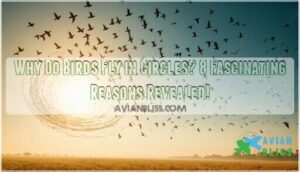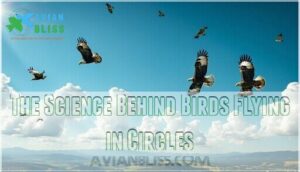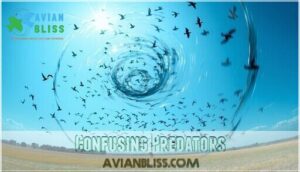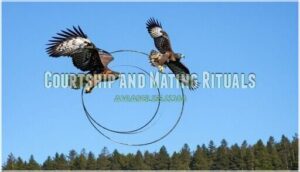This site is supported by our readers. We may earn a commission, at no cost to you, if you purchase through links.
 You’ll spot birds flying in circles for several fascinating reasons.
You’ll spot birds flying in circles for several fascinating reasons.
They’re riding thermals—columns of warm, rising air that act like invisible elevators, letting them soar without flapping their wings.
It’s nature’s energy-saving hack.
Birds also circle during murmurations, those breathtaking group displays where thousands move as one.
Sometimes they’re dodging predators, using confusing aerial maneuvers to escape danger.
During migration, circling helps them navigate and gather with their flock before long journeys.
You might also catch them performing courtship rituals or scanning the ground for food from above.
Each circular flight pattern serves a specific survival purpose, showcasing the remarkable intelligence behind these seemingly simple movements.
Table Of Contents
- Key Takeaways
- Why Do Birds Fly in Circles?
- The Science Behind Birds Flying in Circles
- Thermal Soaring: Nature’s Elevator for Birds
- Murmuration: a Mesmerizing Aerial Display
- Predator Evasion Tactics
- Navigational Purposes During Migration
- Courtship and Mating Rituals
- Feeding Behavior and Food Location
- Frequently Asked Questions (FAQs)
- What is it called when birds fly in circles?
- Why do birds fly in a circular motion?
- Why are birds circling my backyard?
- When birds fly together in circles?
- Why do birds fly in swirls?
- Why do birds fly in circles before a storm?
- What does it mean when birds fly around crazy?
- Why do birds fly in circles at sunset?
- Why do birds fly circular?
- Why do birds fly in circles during migration?
- Conclusion
Key Takeaways
- You’ll see birds using thermal updrafts as natural elevators – They circle to ride columns of warm, rising air that let them gain altitude without flapping their wings, saving tremendous energy during long flights
- They’re executing survival strategies when circling in groups – Birds create swirling patterns to confuse predators, making it nearly impossible for hawks or other threats to target individual birds within the flock
- You’re watching navigation tactics during migration season – Circling helps birds orient themselves using landmarks like rivers and mountains while allowing flocks to synchronize departure times before long journeys
- They’re scanning for food or performing courtship displays – Birds circle to get aerial views of potential prey below or to showcase their flying skills to potential mates during breeding season
Why Do Birds Fly in Circles?
When you spot birds flying in circles, they’re using smart survival tactics that have evolved over millions of years.
These flight patterns aren’t random—they’re purposeful behaviors that help bird species like hawks, vultures, and eagles thrive.
Birds circling overhead are often riding invisible elevators of warm air called thermals, which let them soar without flapping their wings constantly.
This bird circling behavior saves tremendous energy during long flights.
You’ll also see circling birds when they’re avoiding predators, with groups creating confusing swirling patterns that make targeting individual birds nearly impossible.
Why birds circle also includes navigation during migration and spotting food sources from high vantage points.
Understanding these birds circling reasons reveals nature’s ingenious solutions for survival.
The Science Behind Birds Flying in Circles
Understanding bird circling behavior starts with aerodynamics explained through nature’s engineering.
Birds exploit flight mechanics that harness rising air columns called thermals, creating lift without constant wing-flapping.
This evolutionary advantage emerged because energy conservation means survival.
Avian aerodynamics work like invisible escalators.
When you see thermal soaring birds circling, they’re riding these warm air currents upward.
Their sensory perception detects minute temperature changes and air pressure shifts that signal ideal lift zones.
Brain function processes this data instantly, calculating precise flight paths.
Updraft soaring birds like hawks and eagles master this technique, using bird flight dynamics that would make engineers jealous.
The circular pattern keeps them within the thermal’s core, where rising air provides maximum lift.
It’s nature’s way of giving birds free rides to higher altitudes.
Thermal Soaring: Nature’s Elevator for Birds
You’ve probably watched a hawk effortlessly spiral upward without flapping its wings once, riding what scientists call thermal updrafts like a natural elevator.
These rising columns of warm air form when the sun heats the ground unevenly, creating invisible highways in the sky that smart birds use to conserve energy and gain altitude with minimal effort, utilizing these natural phenomena.
Birds turn the sky into their personal highway system, riding invisible air currents like nature’s free elevator service.
How Thermals Form
You’ll witness nature’s invisible elevator system when uneven heating creates warm air density pockets that rise as convection currents.
Picture sunlight hitting a parking lot versus a forest—that temperature difference launches updrafts skyward.
Topography effects from hills amplify this process, creating spinning columns where thermal soaring birds catch free rides upward.
Enthusiasts often utilize specialized thermal soaring equipment to mimic this phenomenon.
Types of Birds That Use Thermals
Three bird types excel at thermal soaring:
- Raptors like eagles – Golden Eagles spend 41% of migration time soaring, barely flapping wings for incredible energy savings
- Vultures with broad wings – Turkey Vultures master "contorted soaring," riding thermals close to ground while scanning for carrion
- Seabirds including pelicans – Great Frigatebirds soar two months straight, reaching 13,000 feet using powerful ocean thermals
These birds utilize rising air currents to gain altitude.
Benefits of Thermal Soaring
Several key advantages make thermal soaring a game-changer for birds.
Energy conservation tops the list, letting them glide effortlessly while gaining altitude without exhausting wing beats.
This reduced fatigue enables extended flight times, perfect for scanning vast areas during foraging.
Hawks and eagles capitalize on these updrafts, achieving remarkable flight efficiency that transforms long-distance travel into an energy-saving masterpiece.
Birds also use specialized soaring equipment to enhance their flight, which is a crucial aspect of thermal soaring as it allows them to fully utilize the benefits of thermal soaring and extended flight.
Murmuration: a Mesmerizing Aerial Display
While birds use thermal soaring for energy-efficient flight, starlings murmuration represents one of nature’s most spectacular group coordination displays.
You’ll witness thousands of starlings creating swirling patterns that seem choreographed yet emerge from simple flocking behavior birds follow.
These mesmerizing aerial shows serve multiple purposes beyond their cultural significance:
- Massive gatherings: Up to 100,000 starlings move as one synchronized unit, creating fluid shapes across winter skies
- Lightning-fast communication: Agitation waves ripple through flocks at 44 feet per second when threats appear
- Strategic positioning: Birds constantly jockey for safer central positions while maintaining flock synchronization
- Heat conservation: Dense formations raise surrounding air temperature, helping birds survive cold nights
This bird group behavior isn’t just beautiful—it’s survival strategy.
These displays are best observed just after sunset, offering a stunning view.
The unpredictable swirling patterns create predator confusion, making it nearly impossible for hawks to target individual birds.
Social bonding strengthens through these displays, with starlings using group coordination to advertise roost sites and share essential information about food sources before settling in for the night.
Predator Evasion Tactics
You’ve probably wondered why birds suddenly burst into swirling aerial dances when danger approaches.
These circular flight patterns aren’t random chaos—they’re sophisticated survival strategies that can mean the difference between life and death, and are a key part of their survival.
Confusing Predators
When predators strike, you’ll see birds deploy clever evasive maneuvers through circular flight patterns.
Nature’s aerial ballet becomes a life-saving dance when danger strikes from above.
This predator disruption strategy creates chaotic movement that confuses attackers, making target selection nearly impossible.
The swirling motion generates "shimmering waves" that disorient aerial threats, while rapid direction changes enhance predator evasion.
These flock dynamics provide a vital survival advantage, transforming individual vulnerability into collective protection against predator detection.
Strength in Numbers
When predators attack, flocking creates incredible advantages through collective defense strategies.
Birds flying in circles harness the dilution effect, where each individual’s risk drops dramatically in larger groups.
This social cohesion strengthens group vigilance against threats.
- Flock safety reduces individual predation risk to 1-in-1,000 odds
- Group vigilance provides multiple eyes detecting approaching dangers
- Social dynamics enable coordinated escape maneuvers at lightning speed
Navigational Purposes During Migration
When you’re watching birds during migration season, you’ll notice they circle to orient themselves using familiar landmarks like rivers, mountains, and coastlines.
These aerial gatherings also help flocks synchronize their departure times and prepare for the long journey ahead, which is crucial for their survival and migration.
Orienting to Landmarks
Beyond predator confusion, navigation becomes paramount during migration. When you watch circling birds, you’re witnessing nature’s GPS system in action. These aerial surveys help birds master Route Familiarity through Visual Cues and Landmark Recognition.
Circling activates Spatial Memory, allowing birds to catalog geographical features like rivers, mountains, and coastlines. This behavior enables Course Correction when environmental changes disrupt familiar pathways.
| Navigation Element | How Birds Use It | Migration Benefit |
|---|---|---|
| Rivers & Coastlines | Follow water features as highways | Reliable directional guides |
| Mountain Ranges | Use peaks as reference points | Natural compass bearings |
| Urban Landmarks | Recognize cities and structures | Modern navigation aids |
| Wetland Stopover Sites | Circle to confirm safe landing zones | Rest and refuel security |
This flight patterns strategy transforms complex terrain into manageable bird navigation routes, ensuring successful journeys across continents.
Gathering for Long Journeys
Imagine a bustling airport where passengers gather before boarding—that’s exactly what happens when migratory species prepare for their epic journeys.
You’ll witness thousands of birds circling above staging areas, synchronizing their departure times and sharing vital navigation intel. This flock coordination isn’t just social hour; it’s strategic migration preparation that guarantees everyone’s energy reserves are optimized.
Through departure synchronization, birds assess weather conditions collectively and familiarize themselves with migration strategies.
Birds utilize Earth’s magnetic field as a key navigational tool. This group cohesion guarantees safe, efficient coverage of vast distances using thermals for bird migration success.
Courtship and Mating Rituals
While navigation helps birds reach their destinations, love takes them on a different kind of journey. When spring arrives, you’ll witness spectacular mating displays as birds fly circles to win hearts and claim territories.
Male red-tailed hawks perform breathtaking aerial spirals, diving and circling at high altitudes to showcase their flight skills. American woodcocks create mesmerizing sky-dance flights, producing whistling sounds through their wings for up to 60 minutes. These ritualistic flights serve multiple purposes: attracting mates, establishing dominance, and defending territorial space.
Courtship behavior varies dramatically across species. Some birds engage in synchronized circling patterns, while others perform solo acrobatics. Females carefully assess these mating rituals, selecting partners based on stamina and coordination displayed during these energetic performances. For example, the American Kestrel’s courtship involves aerial displays, and males often offer food gifts to prospective mates, as part of the courtship ritual.
The spectacle reveals nature’s dating game in action:
- Hearts racing as males spiral skyward in desperate romantic pursuits
- Territories fiercely defended through graceful yet aggressive circular flights
- Bonds strengthened through synchronized aerial dances between devoted pairs
- Competition intensifying as rivals circle each other in territorial disputes
Feeding Behavior and Food Location
You’ve probably wondered why birds seem to circle endlessly above certain areas—they’re actually using a smart hunting strategy.
This aerial vantage point lets them scan large territories for food while communicating potential meal locations to other birds nearby, which is a key part of their hunting strategy.
Spotting Prey From Above
You’ll often spot birds circling high above, using this hunting altitude to maximize their prey detection abilities.
Their keen eyesight can identify small mice and insects from hundreds of meters away.
This aerial scanning technique enhances foraging efficiency by combining energy conservation with ideal visibility.
Smart foraging behavior that turns the sky into their personal hunting ground.
These birds often utilize aerial feeding strategies to capture insects.
Communicating Food Sources
While searching for prey from above, birds also use food source signals to help their flock find meals.
When you see birds circling, they’re often practicing cooperative foraging—sharing information about discovered resources.
Through specific calls and flight patterns, species like crows coordinate group foraging efforts.
This bird communication guarantees everyone benefits from successful prey location discoveries, making survival easier for the entire community.
Frequently Asked Questions (FAQs)
What is it called when birds fly in circles?
Like a dance in the sky, you’ll witness this mesmerizing behavior called "thermal soaring" or "circling flight."
Birds spiral upward in thermal updrafts, conserving energy while gaining altitude for migration, foraging, or predator evasion, which is a key aspect of their "circling flight".
Why do birds fly in a circular motion?
You’ll see birds circling to ride thermals—warm air columns that lift them skyward without flapping. They’re also plotting, communicating with their flock, or avoiding predators through confusing movements.
Why are birds circling my backyard?
Ironically, while you’re wondering about birds above, they’re likely eyeing something below—your backyard probably offers thermals, food sources, or safe roosting spots.
That attract circling flocks seeking energy-efficient flight or group coordination.
When birds fly together in circles?
When birds fly together in circles, they’re using thermals—columns of rising warm air—to gain altitude without flapping.
This energy-saving technique helps them soar efficiently while staying coordinated as a group during migration or daily activities.
Why do birds fly in swirls?
Swirling spectacles showcase strategic survival skills.
You’ll notice birds creating these spiraling patterns to ride thermal updrafts, conserve precious energy during flight, confuse lurking predators, and maintain tight group cohesion while communicating key information about food sources.
Why do birds fly in circles before a storm?
Weather disrupts your normal flight patterns.
You’ll circle in tight flocks to regain balance and direction when storms approach, while testing wind currents to find stable air that’ll keep you aloft during heavy weather.
What does it mean when birds fly around crazy?
When you see birds acting erratic or "crazy," they’re likely responding to immediate threats, weather changes, or using evasion tactics to confuse predators and protect their flock.
Why do birds fly in circles at sunset?
At sunset, you’ll notice birds circling to catch rising thermals—warm air currents that help them soar effortlessly.
They’re also gathering in flocks for roosting, using this time to communicate and coordinate before settling down for the night.
Why do birds fly circular?
Birds absolutely master the art of aerial acrobatics when they fly circular patterns.
You’ll spot them using thermals—those invisible columns of warm air—to glide effortlessly upward while conserving precious energy for survival.
Why do birds fly in circles during migration?
During migration, you’ll notice birds circling to catch thermal updrafts—those rising columns of warm air that let them soar without flapping.
This saves essential energy for their long journey ahead.
Conclusion
Remarkably, these complex aerial patterns that seem aimlessly wandering actually represent some of nature’s most efficient behaviors.
Now that you understand why do birds fly in circles, you’ll appreciate the intelligence behind each graceful movement.
Whether they’re catching thermals like feathered hang-gliders, performing mesmerizing murmurations, or executing survival strategies, birds demonstrate remarkable adaptations.
Next time you spot circling birds overhead, you’ll recognize their purposeful choreography rather than random flight patterns, gaining deeper appreciation for avian brilliance.
- https://bearriverblogger.com/why-do-birds-fly-in-circles/
- https://aerospaceweb.org/question/nature/q0253.shtml
- https://theconversation.com/why-do-flocks-of-birds-swoop-and-swirl-together-in-the-sky-a-biologist-explains-the-science-of-murmurations-176194
- https://www.audubon.org/news/these-masters-sky-can-fly-hours-or-days-while-barely-flapping
- https://archive.org/details/2016-cornell-lab-of-ornithologys-handbook-of-bird-biology-lovette-fitzpatrick/page/86/mode/2up?q=circles











Letha White
December 18, 2024 at 03:41 AM
I’ve been searching the internet for two hours looking for references to something unusual I saw; 2 eagles rising on a thermal, touching left wingtips, circling without separating. Once they reached some height, about 40 feet, one bird drifted above the other and lightly drew its talons across the other birds wing. Courtship?